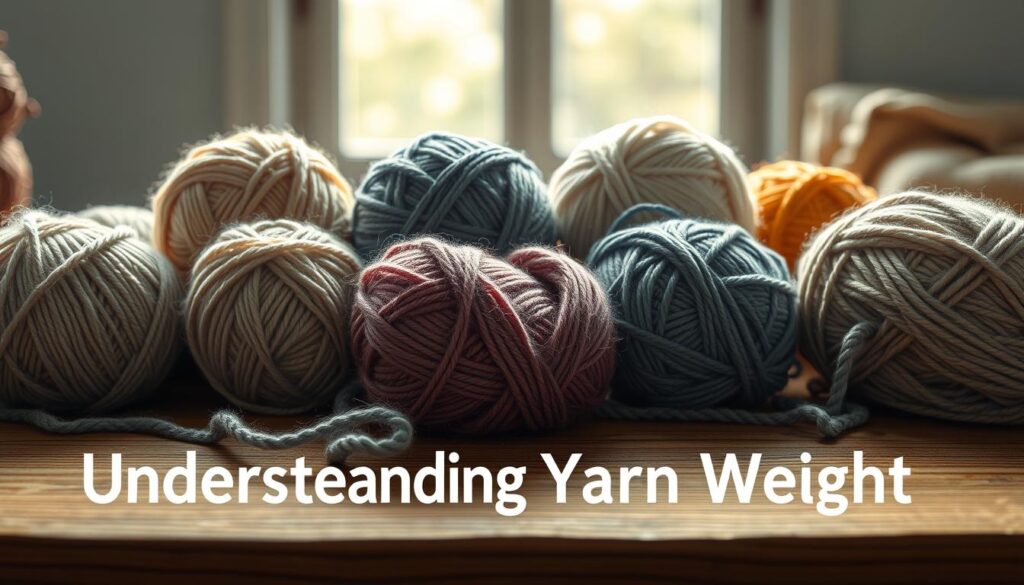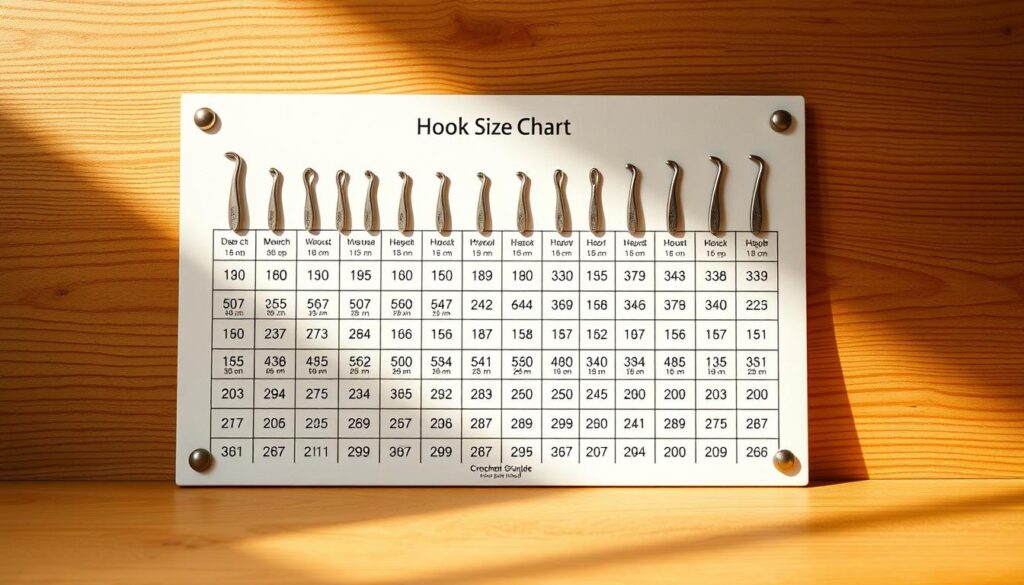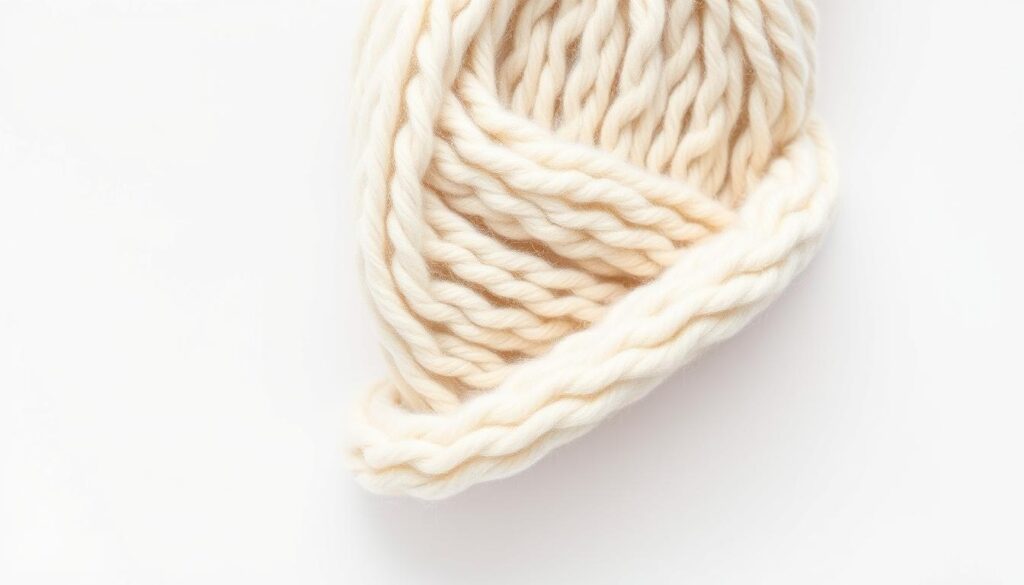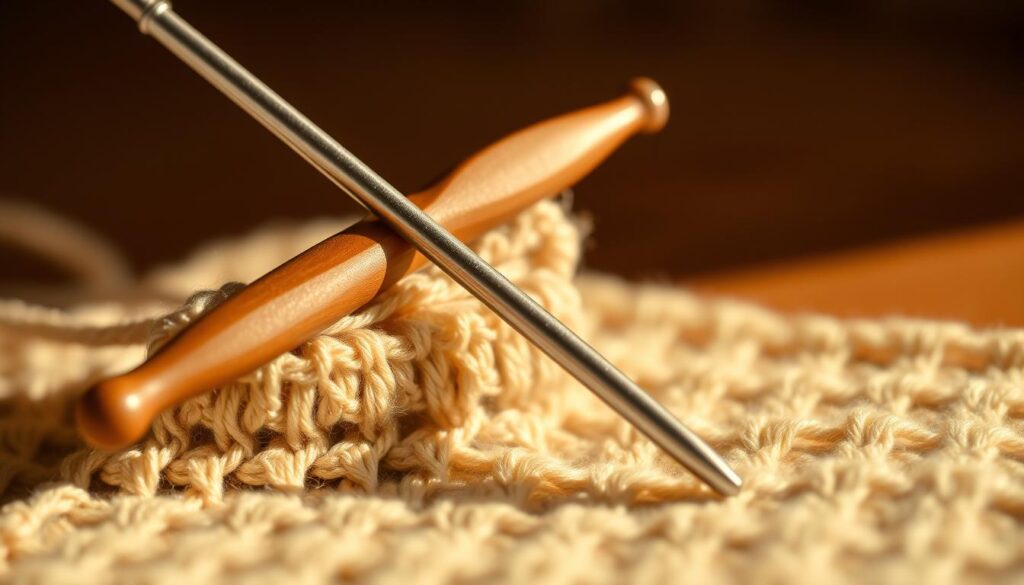Starting your crochet journey means picking the right tools is key. With many yarns and hooks out there, it can feel overwhelming. But, we’re here to guide you through the basics of crochet hook sizes and yarn guide.
Think about the fabric you want to make and the project you’re tackling. Also, consider the yarn weight and hook size for the right gauge. This will help you create beautiful crochet pieces.
Imagine making intricate patterns with ease, using the perfect yarn and hook. The right tools make all the difference. A bigger hook is best for airy weaves, while a smaller one works for dense fabrics like amigurumi. Each yarn label suggests a hook size, linking yarn type to hook choice.
By grasping these basics, you’ll be on your way to making stunning crochet projects.
Key Takeaways
- Choose the right crochet hook size for your project, considering the type of fabric and yarn weight.
- Understand the different types of yarn and their corresponding hook sizes, such as worsted weight yarn and medium-sized hooks.
- Consider the gauge of your project and how it will affect the final result, taking into account the yarn weight and hook size.
- Look for yarn labels that recommend a hook size, and use this as a guide for your project.
- Experiment with different yarn and hook combinations to find what works best for you and your project, and don’t be afraid to adjust your hook size for the right tension.
- Remember to consider the environmental impact of your yarn and hook choices, opting for sustainable and eco-friendly options when possible.
- Invest in a good quality crochet hook and yarn, as they will make a big difference in the quality of your finished project, and consider the price-quality trade-off of eco-friendly options.
Understanding Yarn Weight
Choosing the right yarn is key to a successful project. The craft yarn council has set up standard systems for yarn weights. Yarn weight is measured by wpi (wraps per inch), which shows how many times the yarn wraps around a tool.
Yarn weights range from lace (super fine) to jumbo (super thick). Knowing these weights is crucial for your project’s success. The sizes and materials of your yarn also matter a lot. So, picking the right one is important.
Here are some common yarn weights and their characteristics:
- Lace Weight: 0, 16+ wraps per inch
- Fingering Weight: 1, 14-16 wraps per inch
- Sport Weight: 2, 12 wraps per inch
- DK Weight: 3, 10-11 wraps per inch
- Worsted Weight: 4, 8-9 wraps per inch
- Bulky Weight: 5, 7 wraps per inch
- Super-Bulky Weight: 6, 5-6 wraps per inch
- Jumbo Weight: 7, 4 or fewer wraps per inch

Crochet Hook Sizes
Choosing the right crochet hook is key. You need to know about hook size numbers and letters. Hooks are measured in millimeters (mm) and have a US size. A hook size chart helps you convert between US and metric sizes.
A hook size chart shows US sizes start at B-1, which is 2.25 mm. Larger hooks make a fabric that’s open and airy. Smaller hooks create a dense fabric with fewer holes. For beginners, H-8 (5 mm) is a common size.
Understanding Hook Size Systems
Remember, different makers might have slightly different size systems. Always check your hook’s chart. Yarn labels also suggest the best hook size for your project. This ensures you pick the right hook for your yarn and project.
Here’s a sample chart to help you convert US sizes to metric sizes:
| US Size | Metric Size (mm) |
|---|---|
| B-1 | 2.25 |
| H-8 | 5 |
| J-10 | 6 |

Matching Yarn Weight to Hook Size
When starting a project, it’s key to pair the yarn weight with the hook size. This ensures the right tension and stitch size. A gauge swatch is a small crochet sample used to check the yarn and hook’s fit. The yarn’s thickness and the hook’s size decide the ply and numbers of stitches in your work.
To make a gauge swatch, think about the yarn weight categories. These include DK, aran/worsted, chunky/bulky, and super chunky/super bulky. Each category has a suggested hook size. Using the correct hook size helps your fabric lie flat and even. For instance, DK yarns need a 4mm hook, while chunky yarns need a 6mm to 7mm hook.

- Choose a hook size that matches the yarn weight you’re using.
- Make a gauge swatch to check if your stitches are even and consistent.
- Adjust your hook size if needed to get the right tension and stitch size.
By following these tips, you’ll create a beautiful and evenfabric. Your project will look professional and polished.
The Importance of Gauge
Getting the right gauge is key when crocheting. It makes sure your project fits well. Gauge is how tight or loose your stitches are. It changes how your fabric looks and feels.
To get the right gauge, think about yarn weight, hook size, stitch pattern, and how you crochet. These all play a part.
Getting the gauge right is vital. If you don’t, your project might not fit right. For example, a loose gauge can make clothes too big, while a tight one can make them stiff.
Factors Affecting Gauge
Many things can change your gauge. The yarn you use, the hook size, and your crocheting style are big ones. A bigger hook means looser stitches, and a smaller one means tighter ones.
Yarn type also matters. Thicker yarns need bigger hooks, and thinner ones need smaller ones.
To get the gauge right, follow the pattern closely. Use the hook and yarn sizes it suggests. Crocheting a swatch first can also help. This way, you can make sure your project will fit and look great.

When checking your gauge, look at your stitch tension, hook size, and yarn type. By paying attention to these and following the pattern, you can make a beautiful, professional-looking project.
Reading Yarn Labels
When picking a yarn for your project, it’s key to read the labels well. Yarn labels give lots of info, like what the yarn is made of, its weight, how much you get, and how to care for it. Knowing this helps you pick the perfect yarn for your project.
The yarn’s fiber content is very important. It affects the yarn’s feel, warmth, and how long it lasts. For instance, wool is warm and stretchy, while cotton is cool and absorbs moisture. The label will also tell you the yarn’s weight, which ranges from 0 (Lace) to 7 (Jumbo).
Yarn labels also tell you how much yarn you get, how to wash it, and what hook size to use. Knowing the yardage helps you figure out how many skeins to buy. The care instructions tell you if you can machine wash it or if it needs hand washing. And the recommended hook size helps you make sure your stitches are even.
- Brand name
- Fiber content
- Yarn weight
- Yardage
- Care instructions
- Color name and dye lot number
- Gauge information
By carefully reading the yarn label, you can make sure you pick the right yarn. This way, you’ll get the results you want for your project.
| Fiber Content | Weight | Yardage | Care Instructions |
|---|---|---|---|
| Wool | Medium weight | 400 yards | Hand wash only |
| Cotton | Light weight | 300 yards | Machine wash and dry |
Building Your Crochet Hook and Yarn Collection
Starting your crochet journey means building a good collection of hooks and yarns. Begin with essential sizes like H (5 mm) and I (5.5 mm) hooks. These are great for beginner projects. Also, get versatile yarn weights like worsted weight for durability and drape.
Try out different yarn fibers and textures to find what you like. Cotton, acrylic, and wool blends each bring something special to your crochet. As you grow your collection, add various colors and fibers. This lets you take on many projects with ease.
It’s important to store and organize your crochet supplies well. Use yarn storage bags and project bags to keep things safe and handy. Make it a habit to sort and organize your hooks and yarns. This keeps your workspace neat and prevents tangles.

